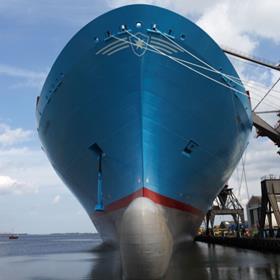
On 12 July 1928, Leise Maersk, the first vessel to depart in our liner service, sailed from Baltimore on the US East Coast en route to the Far East via the Panama Canal. In her holds were 3,600 tonnes of cargo, including Ford car parts and general cargo, the equivalent to 200 twenty-foot containers (TEU). She reached Japan 59 days after departing from Baltimore, before heading for the Philippines where she arrived on the 72nd day. On her homebound voyage, she carried sugar, silk, and oil products.
During the 1930s, Maersk Line expanded this service, called the Panama Line, which then numbered nine modern vessels. In those days, there were no containers – cargo was transported on trucks and trains to the port and stored in warehouses. When the ship arrived, the cargo was moved from the warehouse to the quay and then lifted on board in cargo nets and stacked in the cargo holds. A port stay of a week or more was common as this was a very labour intensive and time consuming process.
Cargo was not the only thing we 'carried'. Pre-1950, Maersk Line offered passenger transport. Cargo liners could carry 12 passengers, who for a reasonable fee could enjoy 'a carefree and restful time with the opportunity of becoming acquainted with life on the seven seas and with the population at the many out-of-the-way places we touch on our way.'
The 1950s was a decade of expansion for Maersk Line especially in the Far East, connecting Japan with emerging markets in South East Asia and the Middle East, the introduction of a 'Round-the-world' line, and inclusion of West Africa in the network.
In 1956, the container revolution was sparked. The first container was shipped aboard the Ideal X from Port Newark, New Jersey to Houston, Texas. The container was the invention of Malcolm McLean. It is said that McLean, while sitting in a truck waiting for the cargo to be reloaded onto a ship, realised that rather than loading and unloading the truck, the truck body itself, with some minor modifications, could be the container that was transported. The benefits of transporting cargo in a container are many – for example, reduced need for warehousing, reduced cargo damage, better logistical opportunities and fast and standardised operations, all resulting in better efficiency and lower costs. As stated by The Economist: 'Without the container, there would be no globalisation.'
It took some time before container shipping really took off. It was not until the late 1960s and early 1970s that agreement was reached on the standards we know today. In 1973, Maersk Line ordered its first dedicated container vessels and in 1975, Adrian Maersk with a capacity of 1,400 TEU undertook Maersk Line's first containerised sailing. In fact, this was on the original Panama Line inaugurated 47 years before.
The container revolution gained momentum in the 1970s and 1980s as more and more cargo was moved in containers. Consequently, new requirements in terms of the ports (specialised terminals with container cranes and areas for container storage) and logistics (documentation and information flow across the transport chain) emerged. In order to best support containerisation, AP Møller applied a more holistic approach to the transport chain. This led to further involvement in terminal and port development and the establishment of a logistics company, Maersk Logistics, originally called Mercantile.
In the 1990s, Maersk Line's focus was cooperation with other lines (P&O Container Lines and Sea-Land) and acquisitions (East Asiatic Company in 1993 and Sea-Land in 1999). The objective, to grow with the customers and meet their requirements as driven by the increasing trade and globalisation, is still valid today. Maersk Line simultaneously developed its vessels: In 1996, Regina Maersk became the world's largest and most modern container vessel with a capacity of 6,000 TEU and a crew of 15; she only ruled the seas for a year as in 1997, the Sovereign Maersk took over with its 6,600 TEU.
In 2006, Emma Maersk, with a capacity to carry more than 11,000 TEU (65 times the size of Leise Maersk) set new standards for economical, safe and environmentally friendly shipping.
Today, 80 years after it all began, Maersk Line is an industry leader and the largest liner shipping company in the world. We will continue to pursue a balanced and sustainable approach towards our business, trade in general, and long term economic growth.
Thank you to all our customers, suppliers and partners for the past 80 years.



